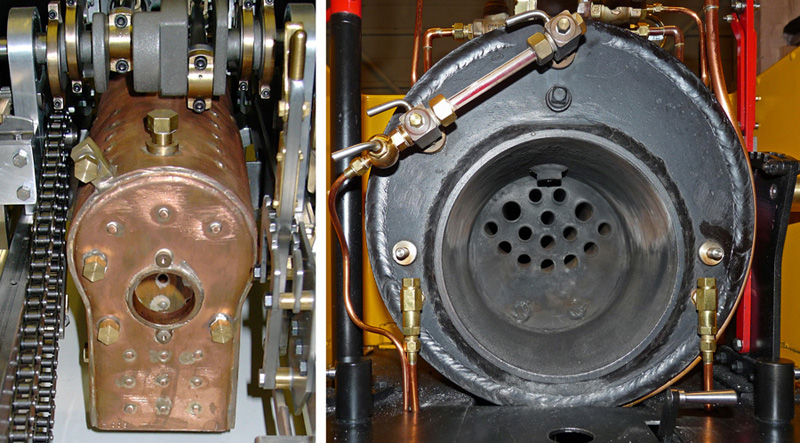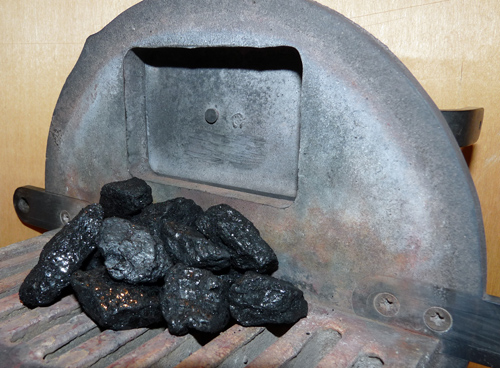 |
 |
 |
An introduction to boilers and
coal
| The purpose of the boiler on a model steam engine is simply to burn something in such a way that it will boil water and create steam to operate the engine, but (as with almost everything) over the years engineers have found many alternative ways of doing this. The significant point about the Stafford class of locomotive is that it uses a marine boiler as opposed to the more normal locomotive style of boiler used on traditional main line steam locomotives. Marine boilers are much simpler to make than traditional locomotive boilers, and the photo below should help to explain the differences. |

|
| The
left of the
photo shows a traditional locomotive boiler (fitted in a steam lorry
that I was once building) while the right of the photo shows the
Stafford's marine boiler (with the firebox door and grate assembly
removed). On the locomotive boiler the firebox door hole is visible in the centre of the boiler face, and the firebox itself continues downwards with straight sides. The grate on which the coal sits was located right at the bottom of the straight sided section of the firebox, and the ash pan (not fitted in the photo) would have extended down from the grate. This structure gives the boilermaker several problems. First, water has to surround the firebox to stop the metal from getting too hot. This means that the fire box itself has to have "walls" fitted inside the boiler shell, with the result that the boiler has several sections made of flat plates. Second, as flat plates tend to bend under pressure the flat plates forming the sides of the firebox have to be connected to the flat plates forming the shell of the boiler with short stays, the ends being riveted over and then silver soldered in place. You can see nine of these stays below the fire box door hole in the photograph, and these stays stop the flat plates from bending apart as the pressure in the boiler increases. All of this double wall and bracing with stays makes the locomotive style of boiler expensive to manufacture. In the marine boiler the firebox is just another round tube fitted inside the round boiler barrel and the grate sits half way up the firebox tube (where the colour changes from black below to brown above). There are no longer any flat surfaces to be braced, so the boiler is much easier to make. If you look at the photos you will also see that the bulk of the boiler's water is high up in the locomotive boiler because of the fire box extending downwards, but the marine boiler has the firebox inside it so the bulk of the water is much lower down. On a traditional steam locomotive the boiler ran along the top of the wheels while the firebox hung down at the back almost to rail level. The marine style of boiler is much better suited to a boat than the locomotive boiler because it isn't so tall and the weight of the water in the boiler being lower down improves the stability of the boat. Hence the name marine boiler, but it's simplicity (and thus lower price) meant that it was frequently used on small industrial steam locomotives. The type of boiler has important differences to you as the fireman. Locomotive boilers frequently have a lot of depth between the firebox door and the grate, whereas the marine boiler often has the grate very close to the bottom of the firebox door (due to its compact design). So in a locomotive boiler you can have a nice deep fire which will burn unattended for a long time, but the marine boiler has a shallow fire which needs small amounts of coal added far more frequently. Also, the marine boiler's grate tends to be much wider than that of a locomotive boiler so you need to ensure that the coal is evenly spread across its entire surface and not just heaped up in front of the firebox door. |
 This
brings us to the matter of the coal itself. You could buy a
bag
of coal from your local coal merchant and then break the nuggets into
suitable small lumps, but it is easier to go to a specialist merchant
who sells coal for model engineers. You will also find that
you
have a choice of types of "coal" to use. You can
buy house
coal, anthracite, steam coal to name a few; and all will burn in
different fashions. Most model engineers will opt for steam
coal
although anthracite, which burns considerably hotter, is also commonly
used. If you want to know more about coal a member of the
Pinewood Miniature Railway Society wrote an excellent article for the
society's newsletter which you can see by clicking here.
(Please
note that it is in PDF format and you will need Adobe Reader, which if
not already installed on your computer is available free by clicking
here.) This
brings us to the matter of the coal itself. You could buy a
bag
of coal from your local coal merchant and then break the nuggets into
suitable small lumps, but it is easier to go to a specialist merchant
who sells coal for model engineers. You will also find that
you
have a choice of types of "coal" to use. You can
buy house
coal, anthracite, steam coal to name a few; and all will burn in
different fashions. Most model engineers will opt for steam
coal
although anthracite, which burns considerably hotter, is also commonly
used. If you want to know more about coal a member of the
Pinewood Miniature Railway Society wrote an excellent article for the
society's newsletter which you can see by clicking here.
(Please
note that it is in PDF format and you will need Adobe Reader, which if
not already installed on your computer is available free by clicking
here.)My personal choice of supplier is Signal Fuels who advertise in the model engineering press and often attend model engineering exhibitions, although they will also send bags of coal to you using commercial carriers. If you have read the PDF article about coal you will realise that different types of coal burn in different ways, and one advantage of buying from Signal Fuels is that their coal is of pretty consistent quality so you don't continually have to adjust your firing technique. The actual size of the lumps of coal you use is not too important, with the proviso that you have to be able to get it through the firebox door ! However if you look at the photo of coal on the Stafford's grate you can see that the larger the lump of coal the less layers of coal you can get on the grate. Coal for model engines is often graded into four sizes of "lumps" frequently called (from smallest to largest) grains, beans, small nuts and large nuts. Despite most fellow model engineers telling me that the coal is very small for such a large model I prefer to use beans. As can be seen in the photo it is easy to build two to three layers of beans on the grate of a Stafford, but the same depth of fire would be attained with only a single layer of small nuts. As it is important that the whole area of the grate is covered with burning coal if the engine is to run efficiently it is much easier to achieve this with the smaller lumps of coal. More will be said about this in the "driving" pages later. The final reason for choosing beans of coal is that they are easily shovelled with the size of shovel that fits the firebox door. Firing the loco whilst actually driving along is (at first) quite difficult to do, so if the coal is easy to scoop up onto the shovel and distribute across the grate the task becomes a little easier. |